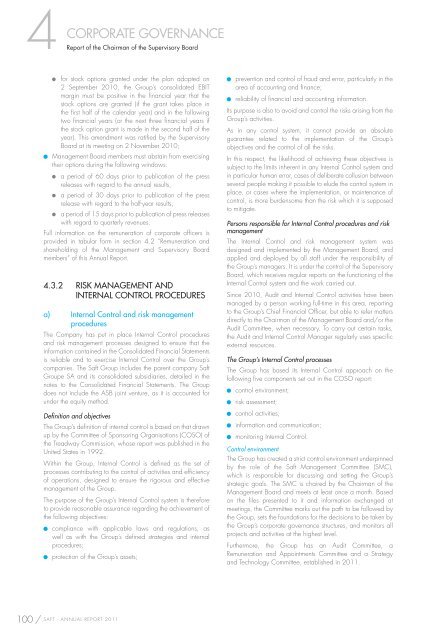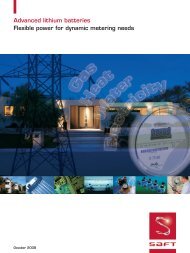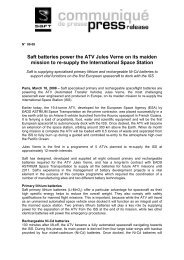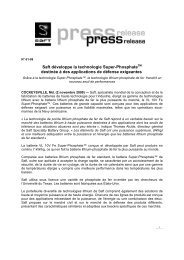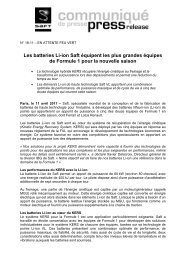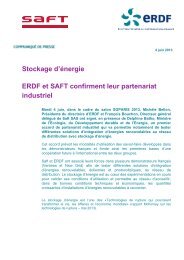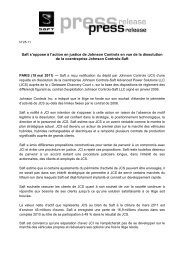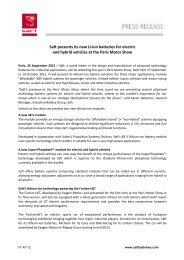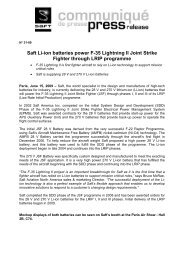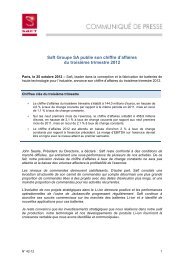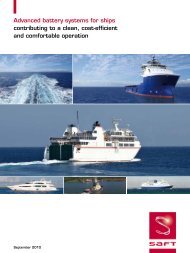ANNUAL REPORT 2011 REGISTRATION DOCUMENT - Saft
ANNUAL REPORT 2011 REGISTRATION DOCUMENT - Saft
ANNUAL REPORT 2011 REGISTRATION DOCUMENT - Saft
Create successful ePaper yourself
Turn your PDF publications into a flip-book with our unique Google optimized e-Paper software.
4 Report<br />
CORPORATE GOVERNANCE<br />
of the Chairman of the Supervisory Board<br />
� for stock options granted under the plan adopted on<br />
2 September 2010, the Group’s consolidated EBIT<br />
margin must be positive in the fi nancial year that the<br />
stock options are granted (if the grant takes place in<br />
the fi rst half of the calendar year) and in the following<br />
two fi nancial years (or the next three fi nancial years if<br />
the stock option grant is made in the second half of the<br />
year). This amendment was ratifi ed by the Supervisory<br />
Board at its meeting on 2 November 2010;<br />
� Management Board members must abstain from exercising<br />
their options during the following windows:<br />
� a period of 60 days prior to publication of the press<br />
releases with regard to the annual results,<br />
� a period of 30 days prior to publication of the press<br />
release with regard to the half-year results,<br />
� a period of 15 days prior to publication of press releases<br />
with regard to quarterly revenues.<br />
Full information on the remuneration of corporate offi cers is<br />
provided in tabular form in section 4.2 “Remuneration and<br />
shareholding of the Management and Supervisory Board<br />
members” of this Annual Report.<br />
4.3.2 RISK MANAGEMENT AND<br />
INTERNAL CONTROL PROCEDURES<br />
a) Internal Control and risk management<br />
procedures<br />
The Company has put in place Internal Control procedures<br />
and risk management processes designed to ensure that the<br />
information contained in the Consolidated Financial Statements<br />
is reliable and to exercise Internal Control over the Group’s<br />
companies. The <strong>Saft</strong> Group includes the parent company <strong>Saft</strong><br />
Groupe SA and its consolidated subsidiaries, detailed in the<br />
notes to the Consolidated Financial Statements. The Group<br />
does not include the ASB joint venture, as it is accounted for<br />
under the equity method.<br />
Defi nition and objectives<br />
The Group’s defi nition of internal control is based on that drawn<br />
up by the Committee of Sponsoring Organisations (COSO) of<br />
the Treadway Commission, whose report was published in the<br />
United States in 1992.<br />
Within the Group, Internal Control is defi ned as the set of<br />
processes contributing to the control of activities and effi ciency<br />
of operations, designed to ensure the rigorous and effective<br />
management of the Group.<br />
The purpose of the Group’s Internal Control system is therefore<br />
to provide reasonable assurance regarding the achievement of<br />
the following objectives:<br />
� compliance with applicable laws and regulations, as<br />
well as with the Group’s defi ned strategies and internal<br />
procedures;<br />
� protection of the Group’s assets;<br />
100 / SAFT - <strong>ANNUAL</strong> <strong>REPORT</strong> <strong>2011</strong><br />
� prevention and control of fraud and error, particularly in the<br />
area of accounting and fi nance;<br />
� reliability of fi nancial and accounting information.<br />
Its purpose is also to avoid and control the risks arising from the<br />
Group’s activities.<br />
As in any control system, it cannot provide an absolute<br />
guarantee related to the implementation of the Group’s<br />
objectives and the control of all the risks.<br />
In this respect, the likelihood of achieving these objectives is<br />
subject to the limits inherent in any Internal Control system and<br />
in particular human error, cases of deliberate collusion between<br />
several people making it possible to elude the control system in<br />
place, or cases where the implementation, or maintenance of<br />
control, is more burdensome than the risk which it is supposed<br />
to mitigate.<br />
Persons responsible for Internal Control procedures and risk<br />
management<br />
The Internal Control and risk management system was<br />
designed and implemented by the Management Board, and<br />
applied and deployed by all staff under the responsibility of<br />
the Group’s managers. It is under the control of the Supervisory<br />
Board, which receives regular reports on the functioning of the<br />
Internal Control system and the work carried out.<br />
Since 2010, Audit and Internal Control activities have been<br />
managed by a person working full-time in this area, reporting<br />
to the Group’s Chief Financial Offi cer, but able to refer matters<br />
directly to the Chairman of the Management Board and/or the<br />
Audit Committee, when necessary. To carry out certain tasks,<br />
the Audit and Internal Control Manager regularly uses specifi c<br />
external resources.<br />
The Group’s Internal Control processes<br />
The Group has based its Internal Control approach on the<br />
following fi ve components set out in the COSO report:<br />
� control environment;<br />
� risk assessment;<br />
� control activities;<br />
� information and communication;<br />
� monitoring Internal Control.<br />
Control environment<br />
The Group has created a strict control environment underpinned<br />
by the role of the <strong>Saft</strong> Management Committee (SMC),<br />
which is responsible for discussing and setting the Group’s<br />
strategic goals. The SMC is chaired by the Chairman of the<br />
Management Board and meets at least once a month. Based<br />
on the fi les presented to it and information exchanged at<br />
meetings, the Committee marks out the path to be followed by<br />
the Group, sets the foundations for the decisions to be taken by<br />
the Group’s corporate governance structures, and monitors all<br />
projects and activities at the highest level.<br />
Furthermore, the Group has an Audit Committee, a<br />
Remuneration and Appointments Committee and a Strategy<br />
and Technology Committee, established in <strong>2011</strong>.


